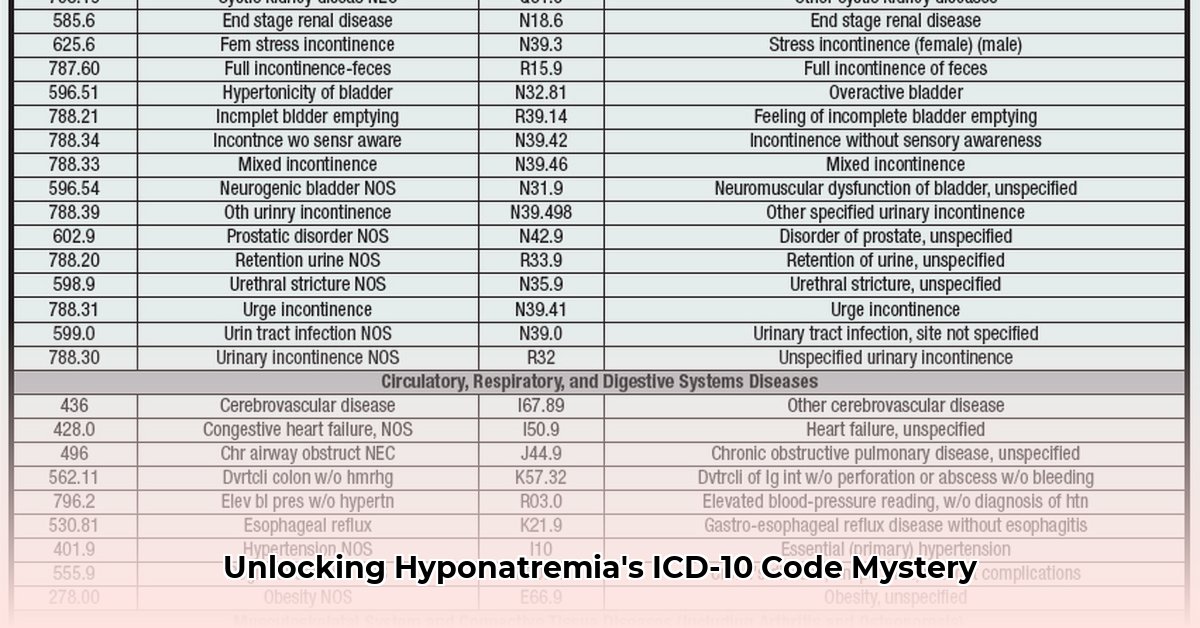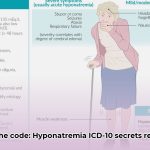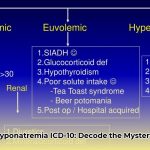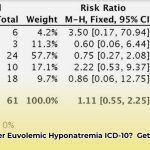Confused about ICD-10 code E87.1 for hyponatremia (low sodium levels)? This guide simplifies the process of understanding and using this code correctly, ensuring accurate billing and optimal patient care. We’ll walk you through the diagnosis, explain common pitfalls to avoid, and provide the tools to confidently handle this specific code. Whether you’re a seasoned coding expert or new to the field, this guide will empower you to avoid costly errors and ensure compliance. Let’s make hyponatremia coding straightforward and efficient. For more detailed information on hyponatremia, check out this helpful resource.
ICD 10 E87.1: Your Comprehensive Guide to Understanding and Coding Hyponatremia
Hyponatremia – the term might sound complex, but the concept is relatively simple. It signifies a condition where the sodium levels in your blood are abnormally low. ICD-10 code E87.1 specifically designates a type of hyponatremia characterized by low blood osmolality, which is a measure of the concentration of particles in your blood. Osmolality reflects the balance of water and dissolved substances like sodium, potassium, and chloride. When both sodium and osmolality are low, it indicates a disproportionate amount of water relative to these solutes. This code is crucial for precise diagnosis, appropriate treatment, and accurate billing practices.
Decoding ICD-10 E87.1: What it Means for Medical Coding and Billing
Think of your blood as a carefully balanced solution. Sodium plays a vital role in maintaining that balance, influencing nerve and muscle function, fluid distribution, and blood pressure regulation. Hyponatremia disrupts this equilibrium, indicating a deficiency of sodium in the bloodstream. E87.1 pinpoints a specific scenario where the blood is not only sodium-deficient but also diluted, as reflected by the low osmolality. Recognizing this specific combination is critical because it helps distinguish this type of hyponatremia from other forms that may stem from different causes and necessitate alternative treatment strategies. Recent studies suggest that hyponatremia affects up to 30% of hospitalized patients, underscoring the importance of proper diagnosis and accurate coding for effective management and reimbursement.
Diagnosing Low Sodium Levels: A Multifaceted Approach
Diagnosing hyponatremia involves more than just a single blood test result; it requires a comprehensive assessment incorporating various factors:
1. Blood Tests: The Primary Indicators: The cornerstone of diagnosis is a blood test revealing low sodium levels (below 135 mmol/L) and low osmolality (generally below 280 mOsm/kg). These values serve as the initial indicators of hyponatremia and hypo-osmolality.
2. Patient History and Symptoms: Doctors must also consider the patient’s symptoms, which can range from subtle to severe. Common symptoms include nausea, headache, lethargy, confusion, muscle weakness, and, in extreme cases, seizures or coma.
3. Assessment of Fluid Balance: Determining the patient’s fluid status—whether they are dehydrated (hypovolemic), normally hydrated (euvolemic), or overhydrated (hypervolemic)—is crucial for identifying the underlying cause of hyponatremia.
4. Identifying the Root Cause: Hyponatremia can be a symptom of underlying medical conditions, such as kidney disease, liver cirrhosis, heart failure, hormonal imbalances (like hypothyroidism or adrenal insufficiency), or even certain medications (like diuretics or antidepressants).
5. Ruling Out Other Conditions: Accurate diagnosis requires excluding other potential causes of low sodium. For instance, E87.1 excludes Syndrome of Inappropriate Antidiuretic Hormone Secretion (SIADH), a condition that also leads to hyponatremia but has a different underlying mechanism.
Mastering E87.1 Coding: Ensuring Accuracy for Billing and Reimbursement
Correctly utilizing the ICD-10 code E87.1 is essential for ensuring appropriate reimbursement for healthcare services and, more importantly, facilitating optimal patient care. Here’s a step-by-step guide to accurate E87.1 coding:
Step 1: Confirming the Diagnosis: Verify that blood tests confirm the presence of both low serum sodium levels and low serum osmolality.
Step 2: Reviewing Exclusion Criteria: Carefully review the ICD-10 guidelines and exclusion notes associated with E87.1 to ensure that it’s the most appropriate code for the patient’s condition. Pay close attention to conditions like SIADH that require distinct coding.
Step 3: Thorough Documentation: Maintain detailed and comprehensive medical records, including lab results, clinical findings, patient history, and any relevant medications or underlying conditions. This documentation serves as the foundation for supporting your coding decisions and preventing potential billing discrepancies.
Step 4: Adding Specificity with Additional Codes: Whenever possible, include additional ICD-10 codes to provide further specificity regarding the underlying cause or contributing factors of the hyponatremia. For example, if the hyponatremia is drug-induced, include a code for the specific medication. If an underlying condition such as heart failure is contributing, include the appropriate code for that condition.
The Frontiers of Hyponatremia Research: Unanswered Questions and Future Directions
While E87.1 provides a framework for categorizing hyponatremia, there are still many aspects of this condition that require further investigation. Ongoing research seeks to better understand the various subtypes of hyponatremia, develop more targeted and effective treatment strategies, and explore the long-term consequences of chronic hyponatremia. Addressing these knowledge gaps will lead to improved diagnostic tools, personalized treatment approaches, and ultimately, better patient outcomes. The economic burden of hyponatremia is substantial, with estimated annual costs exceeding $3 billion in the United States alone, highlighting the need for continued research and innovation in this area.
Understanding the Stakeholders: Perspectives on E87.1
Different healthcare professionals and organizations have distinct perspectives on the significance of E87.1, reflecting their unique roles and responsibilities within the healthcare system:
| Stakeholder | Short-Term Goals | Long-Term Goals |
|---|---|---|
| Physicians | Accurate diagnosis and treatment of hyponatremia; appropriate and compliant code usage | Improved diagnostic tools and treatment protocols; reduced complications and hospital readmissions; enhanced patient quality of life |
| Medical Coders & Billers | Accurate and compliant coding and billing for services; minimizing claim denials | Streamlined billing processes; reduced administrative burden; maximizing revenue cycle efficiency |
| Insurance Providers | Accurate claims processing; prevention of fraudulent or abusive billing practices | Lower healthcare costs; improved risk assessment and management; promoting value-based care |
| Public Health Agencies | Monitoring the prevalence and trends of hyponatremia; identifying at-risk populations | Development and implementation of preventative measures and public health initiatives; reducing the burden of hyponatremia on the population |
| Medical Researchers | Elucidating the underlying mechanisms and causes of hyponatremia; developing novel therapies | Personalized medicine approaches based on individual patient characteristics; improved patient outcomes and reduced mortality |
Mastering ICD-10 E87.1 involves a commitment to accuracy, a deep understanding of hyponatremia, and ongoing engagement with the latest research and clinical guidelines. By utilizing this comprehensive guide and staying informed about advancements in the field, healthcare professionals can confidently navigate the complexities of E87.1 coding, ensuring optimal patient care and streamlined healthcare processes.
A Step-by-Step Guide: How to Accurately Diagnose and Code ICD-10 E87.1 Hyponatremia
Key Takeaways:
- ICD-10 code E87.1 specifically targets hyponatremia, defined as a serum sodium level below 135 mmol/L.
- Accurate diagnosis requires determining the underlying cause—hypovolemic (dehydrated), euvolemic (normal fluid levels), or hypervolemic (fluid overload)—and assessing the severity of the condition.
- Comprehensive documentation, including serum sodium levels, osmolality measurements, patient fluid status assessment, and any related symptoms, is crucial for supporting the code and ensuring accurate reimbursement.
Understanding Hyponatremia and ICD-10 E87.1: Foundational Knowledge for Medical Professionals
Hyponatremia, characterized by low sodium levels in the blood, is a relatively common electrolyte disturbance encountered in clinical practice. It’s essential to recognize that hyponatremia is not a disease in itself but rather a symptom indicative of an underlying imbalance or medical condition. Accurately diagnosing and coding ICD-10 E87.1 hyponatremia necessitates a thorough evaluation of the patient’s medical history, physical examination findings, and laboratory results to pinpoint the underlying cause. The ICD-10 code E87.1 serves as a broad classification encompassing hypo-osmolality and hyponatremia. However, for accurate coding and optimal patient management, further specification is generally required to identify the specific type and cause of the hyponatremia.
Diagnosing Hyponatremia: A Systematic Diagnostic Approach
- Measure Serum Sodium: The initial step involves obtaining a blood sample and measuring the serum sodium level. A reading below 135 mmol/L confirms the presence of hyponatremia.
- Assess Fluid Status: Clinically assess the patient’s fluid status to determine whether they are hypovolemic (dehydrated), euvolemic (normal fluid levels), or hypervolemic (fluid overload). This
- Wellness Fair Ideas for Work to Boost Employee Wellbeing - December 15, 2025
- Affordable Employee Wellness Fair Ideas for Any Budget - December 14, 2025
- Employee Wellness Programs Strategically Benefit Employee Health And Retention - December 13, 2025
















